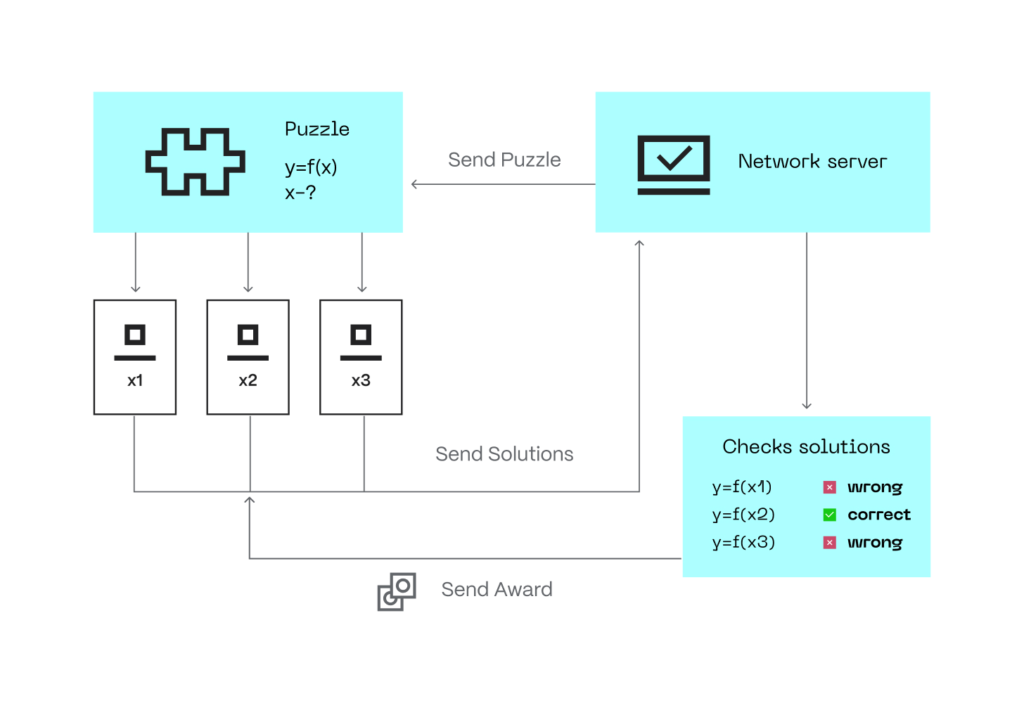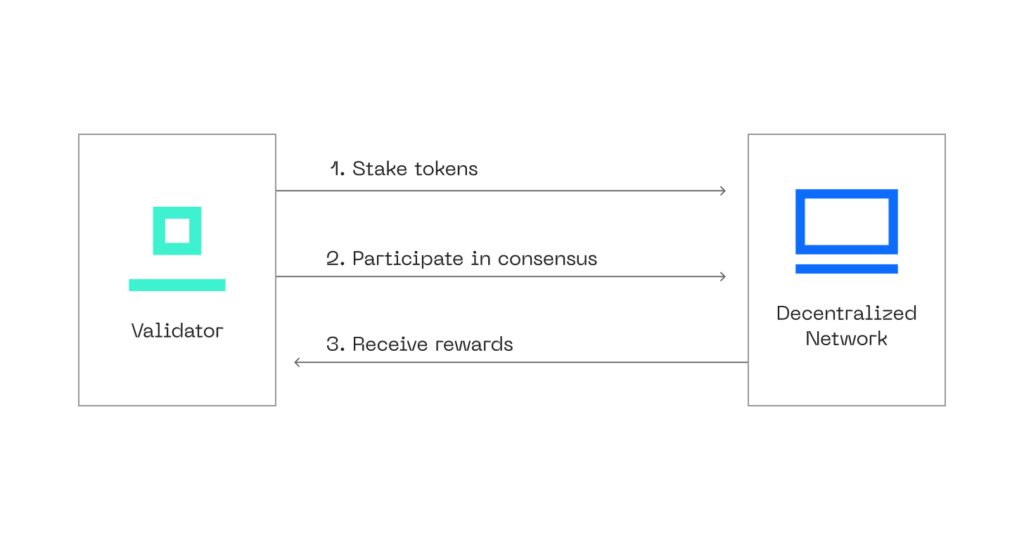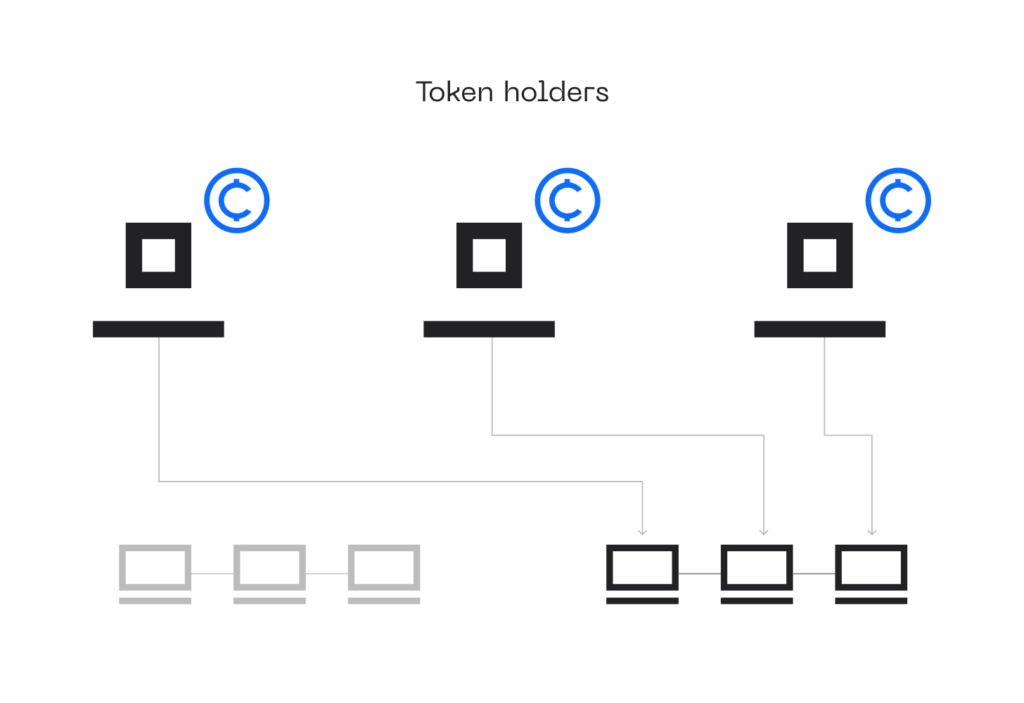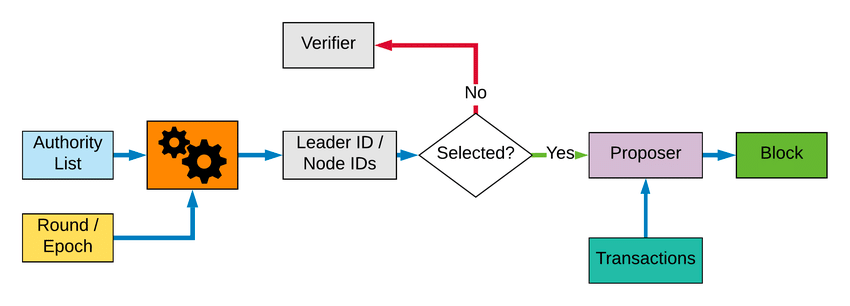So, what makes these algorithms indispensable, and why should you care? This comprehensive guide aims to demystify the pivotal role of consensus in sustaining decentralized infrastructures, offering insights into its multifaceted types, practical applications, and the hurdles it faces. We’ll dissect the complexities, from scalability challenges and security vulnerabilities to the quest for energy-efficient solutions.
What Is a Consensus Mechanism?
In the ever-evolving world of blockchain technology, the term “consensus mechanism” stands as a cornerstone. But what exactly does it mean? A consensus mechanism is a procedure or set of rules that nodes in a network follow to agree on the state of shared data. It’s the backbone that ensures all transactions are verified and recorded in a way that is secure, transparent, and immutable.
Key takeways
- A consensus mechanism is essential for maintaining the integrity and security of a blockchain network.
- It serves as the protocol for achieving agreement among network participants.
- The mechanism is designed to be resistant to faults and malicious activity.
The Role of Consensus in la blockchain
In the context of decentralized systems, consensus isn’t just a concept; it’s a necessity. Blockchain architecture relies on a distributed ledger technology where no single authority holds the power to validate or verify transactions. Instead, this responsibility is distributed among multiple nodes in the network. The consensus mechanism acts as the core procedure for reaching agreement on the state of the blockchain. It enables nodes to agree on the validity of transactions, thereby sustaining the reliability and integrity of the distributed ledger.
The consensus mechanism serves multiple roles:
- Transaction Verification: It ensures that only verified transactions are added to the block.
- Network Security: By requiring nodes to solve complex algorithms or hold a stake in the network, the mechanism adds a layer of security that makes it hard for bad actors to manipulate the data.
- Data Consistency: It helps maintain a single, agreed-upon version of the, which is essential for its functionality.
- Decentralization: The mechanism enables a decentralized network to function effectively, ensuring that no single entity has undue influence over the entire network.
In summary, the consensus mechanism is the beating heart of any blockchain network. It’s what allows for a secure and democratic system of transaction verification, and it’s crucial for the long-term reliability and success of
The Intricacies of Achieving Consensus
Navigating the labyrinthine world of consensus is no small feat. Achieving consensus in a decentralized network is a complex process, fraught with technical and theoretical challenges. Let’s delve into the intricacies that make this endeavor so demanding.
Theoretical Foundations of Consensus
The concept of consensus is rooted in Byzantine Fault Tolerance (BFT), a principle designed to ensure that a distributed system can function correctly even when some nodes fail or act maliciously. In the context, BFT mechanisms serve as the bedrock for creating a fault-tolerant environment. They enable network participants to reach an agreement about the state of the, even in the presence of bad actors or node failures.
Technical Challenges in Achieving Consensus
- Scalability: As a network grows in size and transaction volume, the consensus mechanism must scale accordingly. This is essential for maintaining the network’s speed and efficiency.
- Security: Ensuring the security of a blockchain network is a paramount concern. Consensus algorithms are often targeted by malicious actors seeking to compromise the network. Robust security measures are required to thwart such attempts.
- Energy Efficiency: Proof of Work (PoW) mechanisms, for instance, require significant computational power, leading to high energy consumption. Alternative consensus mechanisms like Proof of Stake (PoS) aim to solve this issue but come with their own set of challenges.
- Decentralization vs. Efficiency: Some consensus mechanisms, like Delegated Proof of Stake (DPoS) or Proof of Authority (PoA), sacrifice a degree of decentralization for increased efficiency and throughput. This trade-off is a subject of ongoing debate in the crypto community.
- Network Latency: Time is a critical factor in blockchain consensus. The mechanism must be designed to handle delays in data transmission and still reach a reliable agreement within a reasonable timeframe.
Historical Evolution of Consensus Mechanisms
The journey of consensus mechanisms is a fascinating tale, marked by innovation and the relentless pursuit of more secure, efficient ways to reach agreement in a decentralized network. Let’s take a trip down memory lane to understand how these mechanisms have evolved over time.
From Early Systems to Modern blockchains modernes
The concept of consensus isn’t new; it has its roots in early distributed systems. However, the introduction of Bitcoin in 2009 by the pseudonymous Satoshi Nakamoto revolutionized the field. Nakamoto implemented a Proof of Work (PoW) consensus algorithm, setting the stage for a new era of decentralized networks.
Over time, the crypto community began to explore alternative methods to achieve consensus. Proof of Stake (PoS) emerged as a less energy-intensive alternative to PoW. Ethereum, initially based on PoW, has been transitioning to a PoS mechanism, known as Ethereum 2.0, to address scalability and energy issues.
Delegated Proof of Stake (DPoS) and Proof of Authority (PoA) were developed to improve transaction speeds and reduce latency. These mechanisms trade a degree of decentralization for increased efficiency, a decision that has sparked debate within the blockchain .
More recently, innovative mechanisms like Proof of Space, Proof of History, and Byzantine Fault Tolerance-based algorithms have been introduced, each with its unique advantages and challenges.
Milestones in Consensus Mechanism Development
- Bitcoin’s PoW: The first successful implementation of a blockchain consensus mechanism.
- Ethereum’s Transition to PoS: A significant shift aimed at solving the scalability and energy consumption issues associated with PoW.
- Introduction of DPoS and PoA: These mechanisms aimed to improve efficiency but sparked debates about the trade-offs between decentralization and performance.
- Emergence of Hybrid Mechanisms: Combining features of PoW and PoS, these offer a balanced approach to consensus.
- Innovations in Fault Tolerance: Byzantine Fault Tolerance and its variations have added a new layer of reliability to blockchain consensus.
A Taxonomy of Consensus Mechanisms
In the multifaceted landscape of la blockchain, understanding the different types of consensus mechanisms is crucial. This section aims to provide a structured guide to these diverse algorithms and protocols, offering a taxonomy that categorizes them based on their key properties and functionalities.
What are the 5 categories of consensus?
Consensus mechanisms can be broadly classified into the following categories:
- Proof-Based Mechanisms: These include Proof of Work (PoW), Proof of Stake (PoS), and their variations. They require nodes to perform certain tasks or hold a stake in the network to participate in the consensus process.
- Authority-Based Mechanisms: Delegated Proof of Stake (DPoS) and Proof of Authority (PoA) fall under this category. They rely on a set of trusted nodes or validators to reach consensus.
- Hybrid Mechanisms: These are combinations of proof-based and authority-based mechanisms, designed to capitalize on the strengths of both. Examples include PoW/PoS hybrids.
- Fault-Tolerant Mechanisms: These are based on Byzantine Fault Tolerance algorithms and are designed to function reliably even when some nodes in the network act maliciously.
- Novel Mechanisms: Emerging mechanisms like Proof of Space, Proof of History, and Proof of Burn (PoB) offer unique approaches to achieving consensus.
Proof of Work, Proof of Stake, and Beyond
- Proof of Work (PoW): The original consensus algorithm used in Bitcoin, PoW requires nodes, often called miners, to solve complex cryptographic puzzles to validate transactions and create new blocks.

- Proof of Stake (PoS): In PoS-based networks like Ethereum 2.0, validators are chosen to create new blocks based on the number of coins they hold and are willing to “stake” as collateral.

- Delegated Proof of Stake (DPoS): This mechanism allows coin holders to vote for a small number of delegates, who then validate transactions and maintain the blockchain.

- Proof of Authority (PoA): In PoA networks, transactions are validated by approved accounts, known as validators. These networks are often permissioned and are considered more centralized compared to PoW and PoS systems.

- Byzantine Fault Tolerance (BFT): BFT mechanisms, such as Practical Byzantine Fault Tolerance (PBFT), focus on achieving consensus even when some nodes fail or act maliciously.

Consensus Mechanisms : overall summary table
| Consensus Algorithm | Key Features | Use Case | Energy Efficiency | Security Level | Decentralization |
|---|---|---|---|---|---|
| Proof of Work (PoW) | Miners solve complex mathematical problems | Bitcoin, Litecoin | Low | High | High |
| Proof of Stake (PoS) | Validators chosen based on coin holdings | Ethereum 2.0, Cardano | High | Moderate | Moderate |
| Delegated Proof of Stake (DPoS) | Elected nodes validate transactions | EOS, Tron | High | Moderate | Low |
| Practical Byzantine Fault Tolerance (PBFT) | Tolerates faulty nodes | Hyperledger, Stellar | Moderate | High | Low |
| Federated Consensus | Pre-selected nodes validate transactions | Ripple, Stellar | High | Moderate | Low |
| Proof of Authority (PoA) | Pre-approved nodes validate transactions | VeChain, POA Network | High | Moderate | Low |
| Proof of Space (PoSpace) | Validators prove disk space | Chia | High | Moderate | Moderate |
| Proof of Capacity (PoC) | Focuses on actual storage capacity | Burstcoin | High | Moderate | Moderate |
| Proof of Activity (PoA) | Hybrid of PoW and PoS | Decred | Moderate | High | Moderate |
| Proof of Elapsed Time (PoET) | Fair leader election | Hyperledger Sawtooth | High | Moderate | Moderate |
| Proof of Importance (PoI) | Considers network usage and balance | NEM | High | Moderate | Moderate |
| Proof of Weight (PoWeight) | Proportional to ‘weight’ held | Algorand | High | Moderate | Moderate |
| Proof of Space and Time (PoST) | Requires storage over time | Spacemesh | High | Moderate | Moderate |
| Tendermint Consensus | PBFT-inspired | Cosmos | Moderate | High | Moderate |

Consensus Across Different blockchains
As the ecosystem expands, it’s crucial to recognize that not all type of blockchains are created equal. Different projects have adopted various consensus mechanisms to suit their specific needs and objectives. Let’s explore how consensus varies across these diverse
Bitcoin’s Approach to Consensus
Bitcoin, the pioneer in the blockchain space, employs a Proof of Work (PoW) consensus algorithm. Miners compete to solve cryptographic puzzles, and the first to solve it gets to add a new block to the chain. This mechanism has stood the test of time but has been criticized for its energy-intensive nature.
How Other blockchains Achieve Consensus
- Ethereum: Initially utilizing PoW like Bitcoin, Ethereum is transitioning to a Proof of Stake (PoS) mechanism to improve scalability and reduce energy consumption. This transition is one of the most watched developments in the
- Solana: This blockchain uses a unique Proof of History (PoH) mechanism to create a historical record that proves that an event has occurred at a specific moment in time. This is combined with a PoS system for added security and efficiency.
- Cardano: Employing a variation of PoS called Ouroboros, Cardano aims to provide a more secure and scalable network.
- Ripple Blockchains, Ripple uses a consensus algorithm that relies on a majority of validators to agree on the order and validity of transactions.
- Hyperledger: This permissioned blockchain uses a Practical Byzantine Fault Tolerance (PBFT) algorithm, focusing on achieving consensus even in an environment where nodes may act maliciously.
- Binance Smart Chain: Utilizes a Delegated Proof of Stake (DPoS) mechanism, where validators are elected by the community to confirm transactions.
Real-World Applications and Use Cases

Blockchain technology has transcended its initial association with cryptocurrencies to find applications in various sectors. The choice of consensus mechanism plays a pivotal role in determining the suitability of a blockchain for different use-cases. Let’s delve into some real-world applications where consensus mechanisms are making a significant impact.
Financial Transactions and Smart Contracts
- Bitcoin and PoW: Bitcoin’s Proof of Work (PoW) mechanism has made it a popular choice for peer-to-peer financial transactions. However, the energy-intensive nature of PoW has led to discussions about its long-term viability.
- Ethereum and Smart Contracts: Ethereum’s transition to a Proof of Stake (PoS) consensus algorithm aims to make smart contracts more scalable and energy-efficient.
- Ripple and Cross-Border Payments: Ripple’s unique consensus algorithm enables quick and secure cross-border transactions, a feature that has made it popular among financial institutions.
Governance and Voting Systems
- Delegated Proof of Stake (DPoS): les blockchains like EOS use DPoS to enable a more democratic governance structure, where coin holders vote for a small set of nodes or validators to reach consensus.
- Proof of Authority (PoA): In permissioned, PoA can be used for governance systems where validators are known and trusted entities, ensuring a high level of security and reliability.
Supply Chain and Logistics
- Hyperledger and PBFT: The use of Practical Byzantine Fault Tolerance in Hyperledger allows for secure and transparent tracking of products throughout a supply chain.
- Cardano and Ouroboros: The scalability and security features of Cardano’s Ouroboros PoS mechanism make it suitable for complex supply chain solutions.
Data Storage and Verification
- Filecoin and Proof of Space: This blockchain uses a Proof of Space mechanism for decentralized data storage, offering an alternative to traditional cloud or server-based storage systems.
- Chainlink and Byzantine Fault Tolerance: Chainlink employs a version of Byzantine Fault Tolerance to securely verify data before it’s added to the blockchain, making it a reliable choice for data verification services.
Scalability and Efficiency Concerns
- Proof of Work (PoW): Bitcoin’s PoW mechanism is often criticized for its scalability issues. The computational power required to solve cryptographic puzzles limits the number of transactions that can be processed per second.
- Proof of Stake (PoS): While PoS mechanisms like Ethereum’s aim to address scalability, they are still in the experimental phase and have yet to prove their long-term efficiency.
Security Risks and Vulnerabilities
- 51% Attacks: Both PoW and PoS networks are susceptible to 51% attacks, where a single entity gains control of the majority of the network’s mining power or stake, compromising its integrity.
- Sybil Attacks: In Delegated Proof of Stake (DPoS) and Proof of Authority (PoA) systems, the risk of Sybil attacks, where a single adversary controls multiple nodes, remains a concern.
- Byzantine Faults: Even with Byzantine Fault Tolerance algorithms, there’s always a risk of system failure if the number of malicious nodes exceeds a certain threshold.
Ethical and Environmental Implications
- Energy Consumption: PoW mechanisms are notorious for their high energy consumption, raising ethical and environmental concerns.
- Centralization Risks: Mechanisms like DPoS and PoA, which rely on a set of trusted validators, risk compromising the decentralized nature of blockchain.
The Future Landscape of Consensus Mechanisms
As we look toward the horizon, it’s clear that consensus mechanisms will continue to evolve, driven by technological advancements and the ever-changing needs of blockchain networks. What can we expect from this dynamic landscape?
Emerging Trends and Technologies
- Layer 2 Solutions: Technologies like Lightning Network for Bitcoin and Plasma for Ethereum are being developed to work alongside existing consensus mechanisms, aiming to improve scalability and transaction speed.
- Sharding: This technique divides a blockchain into smaller, more manageable pieces, or “shards,” each with its own consensus algorithm. Ethereum 2.0 aims to implement sharding to enhance scalability.
- Quantum-Resistant Algorithms: As quantum computing becomes more feasible, there’s a growing need for consensus algorithms that can withstand quantum attacks.
- AI-Driven Consensus: Machine learning and AI could play a role in developing more efficient and adaptive consensus mechanisms.
The Road Ahead: Challenges and Opportunities
- Regulatory Hurdles: As blockchain technology gains mainstream adoption, regulatory compliance will become a significant factor in the development of consensus mechanisms.
- Interoperability: The ability for different blockchain networks with various consensus mechanisms to interact seamlessly is a challenge that the industry is actively working to overcome.
- Community Involvement: The blockchain community’s preferences and needs will continue to influence the development of new consensus algorithms and the modification of existing ones.
- Environmental Sustainability: The search for more energy-efficient consensus mechanisms will remain a critical area of research, given the environmental concerns associated with some existing algorithms.
Conclusion

Blockchain technology has come a long way since its inception, and at the heart of this revolutionary technology lies the critical role of consensus mechanisms. From the original Proof of Work algorithm employed by Bitcoin to the evolving landscape that now includes a myriad of options like Proof of Stake, Delegated Proof of Stake, and Byzantine Fault Tolerance, consensus mechanisms serve as the backbone of blockchain networks.
Summary and Key Insights
- Essential Role: Consensus mechanisms are indispensable for the functionality and security of blockchain . networks. They enable decentralized systems to reach agreement on the state of the ledger, ensuring data integrity and reliability.
- Diverse Landscape: The blockchain ecosystem is rich with a variety of consensus algorithms, each with its unique advantages and challenges.
- Real-World Applications: Beyond cryptocurrencies, consensus mechanisms are finding applications in various sectors, including finance, governance, and supply chain management.
- Challenges and Future Directions: While promising, consensus mechanisms are not without their limitations, such as scalability issues and security vulnerabilities. Ongoing research and technological advancements promise a future of more robust and efficient consensus algorithms.
Final Thoughts
As we navigate the complexities of the digital age, the importance of reliable, secure, and efficient consensus mechanisms cannot be overstated. They are the linchpin that holds the promise of blockchain technology, enabling decentralized networks to revolutionize how we conduct transactions, manage data, and even how we govern. The future holds exciting possibilities, and consensus mechanisms will undoubtedly play a pivotal role in shaping that future.





